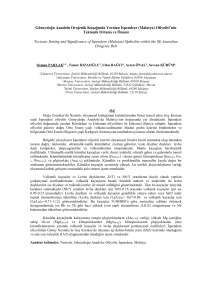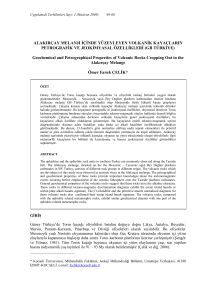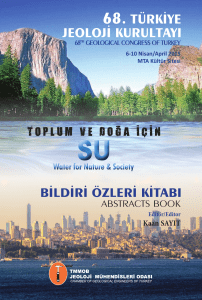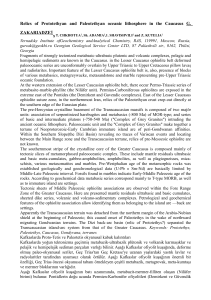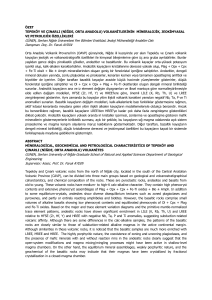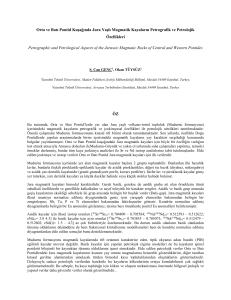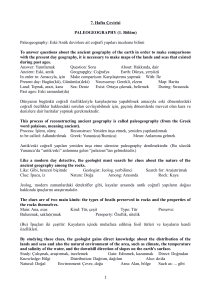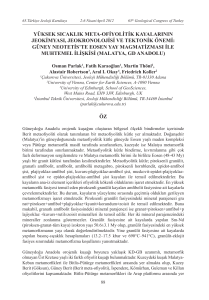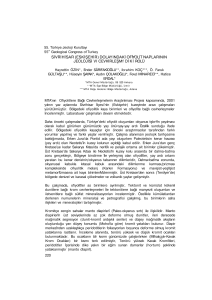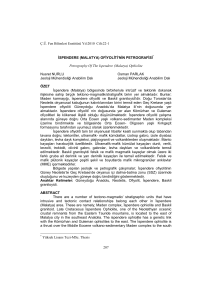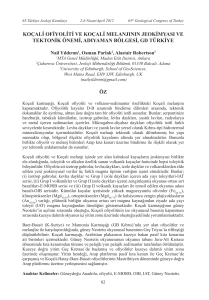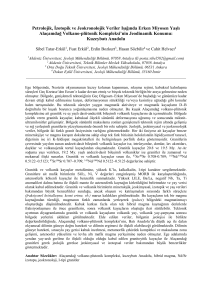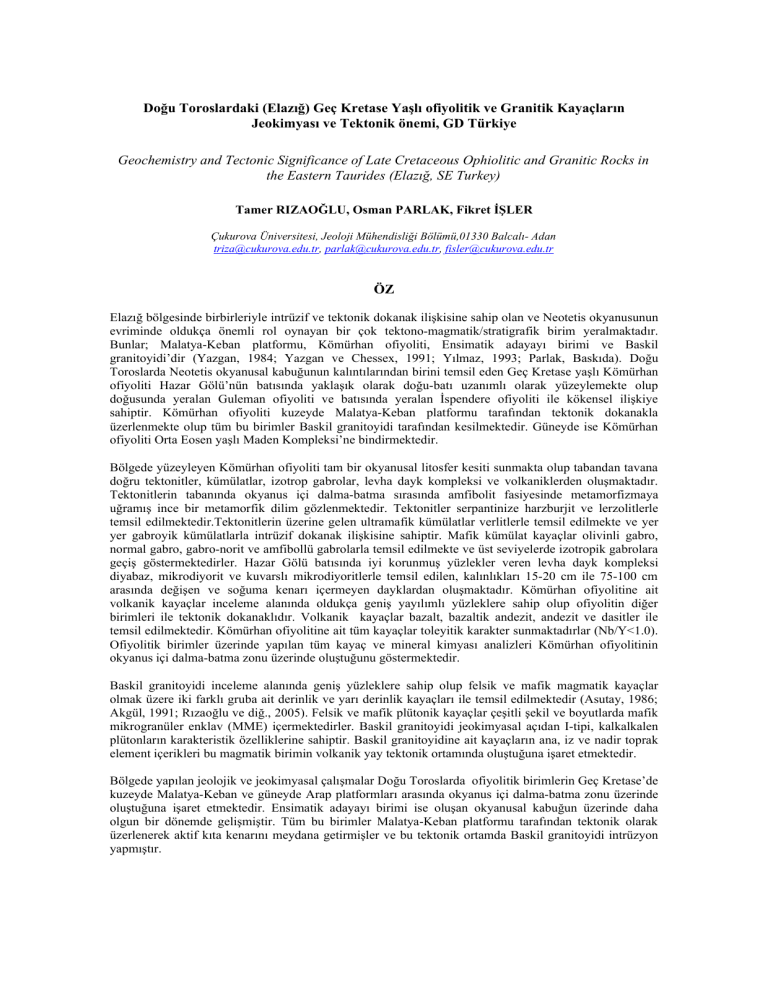
Doğu Toroslardaki (Elazığ) Geç Kretase Yaşlı ofiyolitik ve Granitik Kayaçların
Jeokimyası ve Tektonik önemi, GD Türkiye
Geochemistry and Tectonic Significance of Late Cretaceous Ophiolitic and Granitic Rocks in
the Eastern Taurides (Elazığ, SE Turkey)
Tamer RIZAOĞLU, Osman PARLAK, Fikret İŞLER
Çukurova Üniversitesi, Jeoloji Mühendisliği Bölümü,01330 Balcalı- Adan
[email protected], [email protected], [email protected]
ÖZ
Elazığ bölgesinde birbirleriyle intrüzif ve tektonik dokanak ilişkisine sahip olan ve Neotetis okyanusunun
evriminde oldukça önemli rol oynayan bir çok tektono-magmatik/stratigrafik birim yeralmaktadır.
Bunlar; Malatya-Keban platformu, Kömürhan ofiyoliti, Ensimatik adayayı birimi ve Baskil
granitoyidi’dir (Yazgan, 1984; Yazgan ve Chessex, 1991; Yılmaz, 1993; Parlak, Baskıda). Doğu
Toroslarda Neotetis okyanusal kabuğunun kalıntılarından birini temsil eden Geç Kretase yaşlı Kömürhan
ofiyoliti Hazar Gölü’nün batısında yaklaşık olarak doğu-batı uzanımlı olarak yüzeylemekte olup
doğusunda yeralan Guleman ofiyoliti ve batısında yeralan İspendere ofiyoliti ile kökensel ilişkiye
sahiptir. Kömürhan ofiyoliti kuzeyde Malatya-Keban platformu tarafından tektonik dokanakla
üzerlenmekte olup tüm bu birimler Baskil granitoyidi tarafından kesilmektedir. Güneyde ise Kömürhan
ofiyoliti Orta Eosen yaşlı Maden Kompleksi’ne bindirmektedir.
Bölgede yüzeyleyen Kömürhan ofiyoliti tam bir okyanusal litosfer kesiti sunmakta olup tabandan tavana
doğru tektonitler, kümülatlar, izotrop gabrolar, levha dayk kompleksi ve volkaniklerden oluşmaktadır.
Tektonitlerin tabanında okyanus içi dalma-batma sırasında amfibolit fasiyesinde metamorfizmaya
uğramış ince bir metamorfik dilim gözlenmektedir. Tektonitler serpantinize harzburjit ve lerzolitlerle
temsil edilmektedir.Tektonitlerin üzerine gelen ultramafik kümülatlar verlitlerle temsil edilmekte ve yer
yer gabroyik kümülatlarla intrüzif dokanak ilişkisine sahiptir. Mafik kümülat kayaçlar olivinli gabro,
normal gabro, gabro-norit ve amfibollü gabrolarla temsil edilmekte ve üst seviyelerde izotropik gabrolara
geçiş göstermektedirler. Hazar Gölü batısında iyi korunmuş yüzlekler veren levha dayk kompleksi
diyabaz, mikrodiyorit ve kuvarslı mikrodiyoritlerle temsil edilen, kalınlıkları 15-20 cm ile 75-100 cm
arasında değişen ve soğuma kenarı içermeyen dayklardan oluşmaktadır. Kömürhan ofiyolitine ait
volkanik kayaçlar inceleme alanında oldukça geniş yayılımlı yüzleklere sahip olup ofiyolitin diğer
birimleri ile tektonik dokanaklıdır. Volkanik kayaçlar bazalt, bazaltik andezit, andezit ve dasitler ile
temsil edilmektedir. Kömürhan ofiyolitine ait tüm kayaçlar toleyitik karakter sunmaktadırlar (Nb/Y<1.0).
Ofiyolitik birimler üzerinde yapılan tüm kayaç ve mineral kimyası analizleri Kömürhan ofiyolitinin
okyanus içi dalma-batma zonu üzerinde oluştuğunu göstermektedir.
Baskil granitoyidi inceleme alanında geniş yüzleklere sahip olup felsik ve mafik magmatik kayaçlar
olmak üzere iki farklı gruba ait derinlik ve yarı derinlik kayaçları ile temsil edilmektedir (Asutay, 1986;
Akgül, 1991; Rızaoğlu ve diğ., 2005). Felsik ve mafik plütonik kayaçlar çeşitli şekil ve boyutlarda mafik
mikrogranüler enklav (MME) içermektedirler. Baskil granitoyidi jeokimyasal açıdan I-tipi, kalkalkalen
plütonların karakteristik özelliklerine sahiptir. Baskil granitoyidine ait kayaçların ana, iz ve nadir toprak
element içerikleri bu magmatik birimin volkanik yay tektonik ortamında oluştuğuna işaret etmektedir.
Bölgede yapılan jeolojik ve jeokimyasal çalışmalar Doğu Toroslarda ofiyolitik birimlerin Geç Kretase’de
kuzeyde Malatya-Keban ve güneyde Arap platformları arasında okyanus içi dalma-batma zonu üzerinde
oluştuğuna işaret etmektedir. Ensimatik adayayı birimi ise oluşan okyanusal kabuğun üzerinde daha
olgun bir dönemde gelişmiştir. Tüm bu birimler Malatya-Keban platformu tarafından tektonik olarak
üzerlenerek aktif kıta kenarını meydana getirmişler ve bu tektonik ortamda Baskil granitoyidi intrüzyon
yapmıştır.
ABSTRACT
There are a number of tectono-magmatic/stratigraphic units that have intrusive and tectonic contact
relationships among each other and play considerably important role for the evolution of the Neotethyan
ocean. These are namely; Malatya-Keban platform, Kömürhan ophiolite, Ensimatic island arc unit and
Baskil granitoid (Yazgan, 1984; Yazgan and Chessex, 1991; Yılmaz, 1993; Parlak, Inpress). The Late
Cretaceous Kömürhan ophiolite, one of the Neotethyan oceanic crustal remnants from the eastern
Taurides, crops out as an east-west trending belt to the west of the Lake Hazar, and has a genetic link
with the İspendere ophiolite to the west and Guleman ophiolite to the east. In the north the Kömürhan
ophiolite tectonically overlain by the Malatya-Keban platform and in turn intruded by the Baskil
granitoid whereas in the south it is thrust over the Middle-Eocene Maden Complex.
The Kömürhan ophiolite in the region presents an intact oceanic lithospheric section and comprises from
bottom to top tectonites, cumulates, isotropic gabbros, sheeted dike complex and volcanics. A thin slice of
metamorphic sole rocks, metamorphosed in the amphibolite facies during the intra-oceanic subduction, is
observed at the base of the tectonites. The tectonites are represented by the serpentinized harzburgite and
lherzolite. The ultramafic cumulate rocks overlying the tectonites are represented by wehrlites, and in
some areas they also exhibit intrusive contact relationships with the overlying gabbroic cumulate rocks.
The mafic cumulates are characterized by olivine gabbro, normal gabbro, gabbro-norite and amphibole
gabbro and pass upward into the isotropic gabbroic rocks. Well-preserved sheeted dike complex crops
out to the west of the Lake Hazar and is represented by diabase, microdiorite and quartz-microdiorite
dikes exhibiting variable thicknesses ranging from 15-20 cm to 75-100 cm without pronounced chilled
margins. The volcanic rocks of the Kömürhan ophiolite are wide-spread in the region and have tectonic
contact relationship with the rock units of the Kömürhan ophiolite. They are dominated by basalt,
basaltic-andesite, andesite and dacite. All the rocks of the Kömürhan ophiolite are tholeiitic in character
(Nb/Y < 1). Whole rock and mineral chemistry analyses of the ophiolitic units indicate that the Kömürhan
ophiolite was formed above an intraoceanic subduction zone.
The Baskil granitoid is wide-spread in the region, and characterized by both mafic and felsic plutonic
and subplutonic rock associations (Asutay, 1986; Akgül, 1991; Rızaoğlu et al., 2005). The mafic and
felsic plutonic rocks of the Baskil granitoid contain mafic microgranular enclaves (MME) in different
shape and size. Geochemically, the Baskil granitoid displays the typical characteristics of I-type, calcalkaline plutons. Whole rock major, trace and rare earth element contents of the rocks from the Baskil
granitoid indicate that this magmatic unit was formed in a volcanic arc tectonic setting.
The geological and geochemical studies carried out in the region suggest following late Cretaceous
evolutionary scenario for the eastern Taurides: the ophiolites formed above an intra-oceanic subduction
zone between the Arabian platform to the south and the Tauride platform to the north in Late Cretaceous.
The ensimatic island arc unit formed above the SSZ-type oceanic crust at more matured stage. All the
units were then accreted to the base of the Malatya-Keban platform to form the Tauride active
continental margin. Finally the Baskil granitoid intruded all the former units in a volcanic arc setting.
Değinilen Belgeler
Akgül, M., 1991. Baskil (Elazığ) Granitoyidinin Petrografik ve Petrolojik Özellikleri. Geosound, 18: 67-78
Asutay, H. J., 1986. Baskil (Elazığ) Çevresinin Jeolojisi ve Baskil Magmatitlerinin Petrolojisi. M.T.A Dergisi, 107:
49-73.
Parlak, O., Baskıda. Geodynamic Significance of Granitoid Magmatism in the Southeast Anatolian Orogen:
Geochemical and Geochronogical Evidence from Göksun-Afşin (Kahramanmaraş, Turkey) Region.
International Journal of Earth Sciences
Rızaoğlu, T., Parlak, O., Koller, F., Höck, V., and İşler, F. (2005) Geochemistry and tectonic significance of the
Baskil granitoid rocks from the Southeast Anatolian Orogen (Elazığ, Turkey). International symposium on the
geodynamics of easter Mediterranean: active tectonics of the Aegean region. 15-18 June 2005, Kadir Has
University, İstanbul, Turkey, p. 228.
Yazgan, E., 1984. Geodynamic Evolution of the eastren Taurus Region (Malatya- Elazığ area, Turkey), Proceedings
of International Symposium, Geology of Taurus Belt, MTA, Ankara, 199-208.
Yazgan, E., and Chessex, R., 1991. Geology and Tectonic Evolution of the Southeastern Taurides in the Region of
Malatya, Turk Assoc Petrol Geol.,3:1-42.
Yılmaz, Y.,1993. New Evidence and Model on the Evolution of the Southeast Anatolian Orogen, Bulletin Geological
Society of America, 105:251-71.

